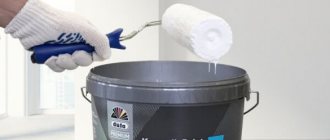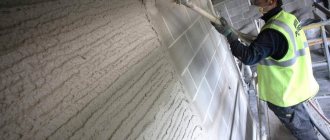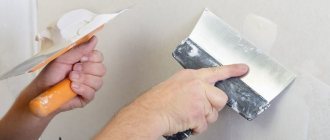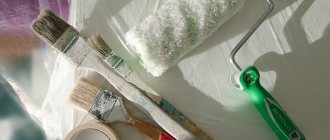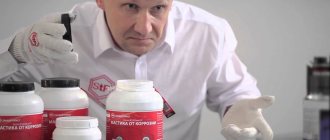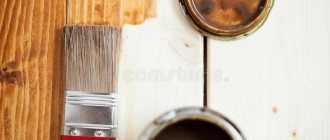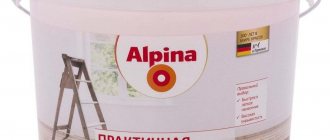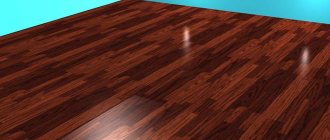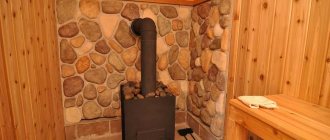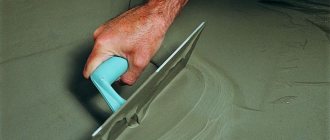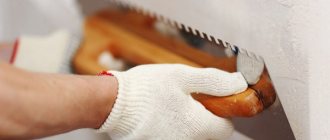Rating of the best paints for walls
In many ways, the choice of one type of paint or another depends on the operating conditions of the surfaces in the room where the walls are to be painted, the microclimate in it, as well as the material of the walls. The highest load on the wall material occurs in the kitchen. This is due to increased humidity, moisture, grease, hot steam, and other contaminants on the walls. Therefore, it is better to choose latex or silicone paint here. Acrylic compositions can be chosen for living rooms and bedrooms. To paint the walls in a nursery, it is better to choose a composition that has the appropriate mark on the packaging.
Acrylate paint
The acrylate type contains polyacrylate, which can be plexiglass or another type of substance. After drying, a film-like coating is formed on the surface, which is reliable.
The positive aspects of acrylate compositions described below can be highlighted:
- No toxic elements;
- Versatility, applicable on different types of materials;
- High level of adhesion;
- The texture allows you to get a rich color that does not fade over time;
- Resistant to different temperatures and high humidity;
- Good elasticity;
- The surface can be washed with detergents.
After drying, a film-like coating is formed on the surface, which is reliable.
The best water-soluble compounds
The popularity of this paint is due to its low cost and practicality:
- it dries quickly;
- Can be easily painted in any color using a pigment;
- does not smell;
- Suitable for most grounds.
The disadvantages of inexpensive emulsions are poor mechanical resistance, rapid contamination, and fear of moisture. This material is only suitable for painting ceilings in rooms with normal humidity.
Interior emulsion "Universal" from "TEX"
For painting walls in the bedroom, living room, nursery and other rooms with normal humidity levels. After drying, a vapor-permeable coating with a matte effect is formed on the surface of the walls. The paint adheres well, evenly covers concrete, plastered, brick, wood and plasterboard substrates, and is economical in consumption. Initially white paint can be tinted to any shade if necessary.
pros
- environmental friendliness;
- does not smell;
- quick drying;
- economical consumption;
- affordable price;
- does not form splashes or drips.
Minuses
- not suitable for rooms with high humidity.
Interior emulsion “Profi” from “TEX”
A multifunctional composition that can be used in rooms with dry and humid microclimates - kitchen, bathroom, bedroom, living room, children's room. After the paint dries, a “breathing” and very durable, wear-resistant layer is formed on the surface of the walls. Suitable for most types.
pros
- can be tinted;
- hiding power;
- has no smell;
- dries quickly;
- economical consumption;
- does not form splashes or drips.
Minuses
Interior emulsion from LAKRA
Water-dispersion paint forms a matte, uniform coating after drying. Available in white. Can be tinted in light shades. 1 kg of paint is enough for an average of 6-8 m2. It is used for painting walls in rooms with normal microclimate and humidity. Excellent coloring of porous surfaces.
pros
- economical consumption;
- durable front layer;
- adhesion to the base;
- can be washed.
Minuses
- there is a smell.
Paint "Vinyl Matt base BW" from "Dulux"
After drying, it creates a deep matte finish on the surface. It is characterized by high smoothness. Masks the imperfections of the base. Can be tinted in any shade according to all current catalogs. The paint is easy to apply, does not leak or splash.
pros
- does not smell;
- can be washed;
- lays down evenly and masks imperfections in the base.
Minuses
- high price.
Advantages and disadvantages of painting walls
Let's start with the advantages:
What immediately comes to mind is that with the help of paint you can realize any of your dreams of creating a specific color, since there are many options on the market, and all this is complemented by the ability to create shades at your own discretion;- with proper surface preparation, the finished coating will remain intact and intact for a long time, without cracking;
- It’s easy to remove stains and stains from a painted surface; most can be washed thoroughly without fear of damage;
- the paint will certainly not be of interest to pets, so there will be no scratches, like on wallpaper, for example;
- If a stain or defect has formed, it can be easily eliminated - you just need to tint it, i.e. there is no need to replace the entire coating, everything is simple, easy to do and inexpensive;
- if the room has complex elements, such as arches, ledges, etc., then painting the walls will be much easier than, for example, gluing wallpaper;
- You can repaint the walls or change the shade a little faster than if you want to re-glue the wallpaper.
The main disadvantages of painting walls include:
- the need for careful preparation of the walls so that the result is truly appropriate;
- at first glance, painting the walls is a mere trifle, but, in fact, an ideal surface is obtained only with appropriate preparation of the surface;
- many still believe that painting one color is boring and definitely not suitable for the home, but one can argue with this, because everyone has different tastes, and no one bothers painting one wall in a different color;
- paints, although resistant to mechanical stress, may not withstand a more or less strong blow to the surface;
- Almost all paints, except glossy ones, are capable of absorbing dust from the air.
The best acrylic compounds
Paint with an acrylic base forms a thin protective coating that is resistant to mechanical stress and moisture. This type of coating paints equally well on concrete and wood surfaces. The main condition is that the base surface must be carefully prepared and leveled.
Paint "Optimum"
The paint is used to paint walls and ceilings. Suitable for finishing new and putty-prepared concrete, aerated concrete, brick, plasterboard and wooden bases. The paint is intended for rooms with normal humidity. Creates a deep matte finish.
pros
- does not create glare;
- lays down evenly;
- economical consumption;
- dries quickly.
Minuses
- dry cleaning only.
Acrylic-based paint "Alpina Renova"
Interior paint from the Caparol Group under the Alpina Renova brand can often be found at the top of the ratings. After painting, it creates a matte finish that remains perfectly snow-white throughout the entire service life of the decorative layer - from 5 to 7 years. The paint can be tinted perfectly in any shade. Experts recommend using a coloring pigment from the same manufacturer. This will preserve the durability of the coating and the brightness of the shade. The paint is universal and can be used for painting walls in rooms with temperature changes and high humidity.
pros
- easy care of the coating;
- after wet cleaning, the intensity of the shade is maintained;
- excellent adhesion to the base;
- Not too thick and not runny consistency.
Minuses
- high consumption.
“Joker” paint from “Tikkurila” acrylic
Eco-friendly acrylic-based matte paint, recommended for painting walls in children's rooms and bedrooms. It is diluted with water and has no odor. Suitable for porous substrates - concrete, brick, plaster, as well as gypsum board. Dries in 5 hours. You can apply it using a spray gun or manually (brush, roller).
pros
- hiding power;
- thick consistency;
- no smell;
- dries quickly;
- can be washed.
Minuses
- high price.
Paint “PL-07A” from “Profilux”
Paint for finishing walls in rooms with a normal microclimate. The composition is easy to apply, it does not spread, does not form streaks. Creates a uniform matte layer on the surface. Suitable for any substrate. After drying, it can be subjected to light wet cleaning. Water is used for dilution.
pros
- environmental friendliness;
- without smell;
- uniform layer.
Minuses
- long drying time.
Paint "Weiss" from "ECO" on an acrylic basis
Abrasion-resistant, deep-matte, environmentally friendly paint made in Germany for walls and ceilings. It is characterized by high wear resistance and vapor permeability. Suitable for painting wallpaper. Water is used for dilution.
pros
- no odor;
- environmental friendliness;
- long lasting color;
- hiding power;
- doesn't smell.
Minuses
- not detected.
How to paint walls correctly
Painting correctly is not difficult, you just need to take a few simple steps:
- choose the right paint;
- purchase related materials (gloves, masking tape, brush/roller/spray, primer, paint tray);
- qualitatively prepare the surface for finishing;
- apply paint carefully.
The surface must be clean, level and dry. To do this, you need to clean the wall of old material if it was previously painted. If this is wallpaper, then you should remove it with a spatula, sand the old flaking paint to a clean base. Fill cracks and chips with starting and then finishing putty and sand with sandpaper.
Then a layer of primer should be applied (the primer ensures good adhesion of the paint to the wall and removes dust from the surface). On a new wall, which itself is smooth and has no defects, a simple primer is sufficient.
The paint should also be prepared - stirred using a drill attachment or screwdriver. This is necessary for uniform consistency of the material. After long-term storage, the fillers in the composition settle to the bottom, as a result of which the paint in the upper layers is less thick than at the bottom. If necessary, the material can be diluted with water or a solvent (information about the diluent and acceptable dilution proportions is usually indicated on the packaging).
For painting, use a roller, brush or spray gun. The diluted composition is poured into the tray in small portions and the roller is dipped into it, rolled out on a special section of the tray to remove excess material from the roller, and then rolled out along the wall. Painting in rooms should begin on the wall farthest from the exit. In narrow areas (at the junction with windows, ceiling) they work with a small brush, large areas are treated with a roller. Using a brush and roller, rub the material well and roll it so that there are no smudges or missing spots left on the surface.
The packaging indicates how many layers must be applied to obtain the result. If the material is applied in two or more layers, be sure to wait until the first one dries so as not to reduce the quality of the paint. Work carefully, try not to paint over skirting boards, cornices, and windows adjacent to the walls. You can use masking tape to protect them. After finishing work, be sure to wash your brushes, roller and tray.
The best silicone compounds
Paint with silicone resins appeared on the construction market not so long ago, but has already gained popularity due to its unique characteristics. These are universal compositions for interior and exterior wall decoration, resistant to mechanical stress, sunlight, and atmospheric conditions. The coating has heat resistance and antiseptic properties. The main disadvantage is the cost. It is higher than other types of interior paint. Most often you can find acrylic paint containing silicone on sale.
Paint "Caparol" "CapaSilan"
This durable matte paint does not contain solvents. The main advantage of this paint is that when applied even in a poorly lit room, a uniform monolithic coating is obtained on the wall without noticeable overlap of adjacent areas. The composition of the paint meets current sanitary standards. The coating is suitable for porous substrates and has high hiding power. “Caparol” “CapaSilan” paint can be used in rooms with high requirements for environmental friendliness and hygiene of finishing materials.
pros
- easy to apply;
- there is a water-repellent effect;
- can be washed and used in rooms with high humidity.
- hiding power.
Minuses
- high price.
Paint "Euro Extra 20" from "TIKKURILA"
Paint from a recognized leader in Finnish-made paints and varnishes. This type of silicone paint has some of the advantages that only silicone paint can have: color purity, resistance to sunlight, water resistance. The paint is easy to apply, odorless, and the coating can be washed with standard detergents.
pros
- environmentally friendly composition;
- easy application;
- UV resistance;
- long service life of the coating;
- moisture resistance;
- no smell.
Minuses
- high price.
Paint "Litotherm Paint Sil" from "LITOKOL"
Reliable protection of the base from external influences, moisture and dirt, as well as resistance to UV, combined with an affordable cost, have made LITOKOL brand silicone paint a popular product with the characteristics of a Premium category material. One of the advantages is a wide range of shades. The downside is that a high-quality and durable decorative coating can only be obtained by using other products (plaster, putty, primer) together with this paint.
pros
- moisture-resistant coating that can be washed;
- large selection of shades;
- resistance to external influences.
Minuses
- compatible only with LITOKOL brand materials.
What does light green go with?
Juicy yellow-green will attract all attention and become a bright accent in any interior. What colors should you combine this spectacular and complex shade with to create a harmonious and balanced room design?
Combination of light green color with other shades in the interior
1. Dairy. White is the ideal backdrop for any bold decisions: it can easily withstand even neon colors and does not distract attention. Choose not a cold snow-white, but a softer milky one: its warm undertone goes well with the yellow in light green. Complement this union with objects made of light wood, and you will get a current eco-style interior - minimalistic, but very original.
Combination of light green and white in the interior
Combination of light green and milky white colors in the interior
Light green and white in interior design
2. Beige. Lime accents on a beige background are an excellent alternative to traditional pastel colors in the interiors of country houses in the classic and Provence styles: this color “continues” the landscape outside the window, dissolving the boundaries between the living room and the garden. This combination looks especially good on textiles with floral or ethnic prints.
Combination of light green color with different shades of beige
The combination of light green and beige in the interior, photo Jonathan Adler
Light green and light beige color in interior design
3. Brown. Dark chocolate color - deep, rich, noble and quite conservative - creates a stylish contrast with neon salad, which immediately makes the interior more thoughtful and sophisticated. Natural dark wood can also act as brown.
Combination of bright green and brown in the interior
Combination of light green color with chocolate brown
Combination of light green walls with dark wood elements
You should not use a duo of black and light green in residential areas: it looks rather heavy and can cause an oppressive feeling. This combination looks better in offices and other public spaces, and in an apartment or house, replace black with a less dramatic dark brown.
Using light green accents on a taupe sofa
4. Gray. The entire palette of gray shades, like white, is an excellent background for experiments. In the case of grassy green, choose a lighter gray color scheme - it perfectly “mutes” the saturation of this tone and balances its daring temperament. In turn, such a rich color prevents the interior in a cold steel palette from looking boring and dull: small bright accents in the form of decor or textiles add the necessary positivity to a monochrome design.
Using light green accents on a taupe sofa
Bright green accents in gray interiors
Light green elements in a light gray interior
5. Powdery. In combination with muted pastel pink, let the salad color dominate: against its background, the soft “marshmallow” shade reveals itself especially delicately. This union is more appropriate than ever in Provence or ethno style interiors, as it resembles the natural combination of young leaves and blooming buds.
Light green accents on a powdery sofa
Powder pink and lime colors in the interior
Bright green and powder pink in interior design
6. Orange. From fashionable coral to invigorating orange - any of these shades of orange looks harmonious with light green, because this combination is taken from nature itself. Thanks to associations with ripe citrus fruits surrounded by greenery, such an interior looks as cheerful as possible. This color scheme will be more appropriate than ever in a nursery, a home office of a representative of a creative profession, or just a living room for noisy parties with friends. At the dacha or in a country house for a summer holiday, orange and lime will help create an atmosphere of a carefree vacation.
Orange and light green colors in interior design
Yellow-orange and light green accents in the interior in neutral colors
The combination of orange and light green in the interior of the room
7. Yellow. Since light green has a pronounced presence of yellow, it will a priori form a balanced combination with this shade. It doesn’t matter what the color itself is - soft pastel, lemon or muted mustard - the union with lime will look advantageous. This design looks best in the living room, kitchen and dining room, while for the bedroom it is too “invigorating” and can cause problems with sleep.
Light green details in a pastel yellow interior
Bright green and lemon yellow colors in the interior
Yellow accents in the interior in light green tones
8. Blue. Pure and bright shades of blue - ultramarine, cobalt, sapphire - are best combined with salad. This is another case when you need to allow one of the two shades to dominate, and make the other only its complement, otherwise the interior will visually “crush” and cause fatigue. Lime accents on a blue background or blue on a lime background - choose one of the two.
Combination of light green and dark blue in the interior
Laconic light green accents on a bright blue background
Light green furniture goes well with blue walls
9. Lilac. A very bold and unusual solution - purple details on a bright green background. The reverse relationship is also acceptable: for example, several salad-colored pillows on the sofa will become a stylish addition to the living room in purple tones. Both of these options are more suitable for Art Deco and mid-century modern styles - here the bright details and “theatrical” riot of colors are really justified.
Lilac furniture in a light green room
Light green accents on a dark purple sofa
Bright green chairs in an interior in lilac tones
The best latex compounds
The aqueous emulsion contains latex copolymers. This makes the paint layer durable and waterproof. Therefore, latex paint can often be found on the walls in the bathroom or kitchen. The peculiarity of this paint is that it forms a thin protective film on the surface and does not overlap the texture of the base, which allows it to be used to protect artificial stone or brick in the decor of a kitchen or bathroom.
NewTone Sky paint
For a super white finish, use this latex paint. It is recommended to use it in rooms with a dry microclimate and normal humidity levels. The paint is suitable for all types of substrates - brick, wood, concrete, plasterboard and plaster. With the help of color you can get any shade.
pros
- environmental friendliness;
- affordable price;
- versatility.
Minuses
- not economical consumption;
- poor hiding power.
Paint "Retail Eurolatex 3" from "Dufa"
Paint from a German manufacturer with the highest European quality has an affordable price. Economical consumption and high hiding power make the work process easier. On the surface, the paint creates a durable, washable coating. To remove dirt, you can use detergents containing alkali. This allows the paint to be used in the kitchen.
pros
- durable durable coating;
- hiding power;
- resistance to alkali.
Minuses
- paint with colored pigment dries and darkens.
3D White paint from Dulux
Latex super white paint with a matte effect for wallpaper, drywall, plaster, concrete and brick surfaces. Can be tinted. Dries in 4 hours. Applied manually and mechanized. Dilute with water.
pros
- snow-white;
- hiding power;
- without smell;
- can be washed.
Minuses
- high price.
Bindo 7 BW paint from Dulux
Professional paint and varnish material with a matte effect. Lays down smoothly and does not form smudges or splashes when applied with a brush or roller. The paint is intended for use in rooms with high hygiene requirements for finishing materials. The environmentally friendly composition allows you to use this latex paint in the kitchen and children's room. Perfectly emphasizes the relief of textured wallpaper for painting. After drying, the decorative layer can be washed with mild detergents and non-abrasive sponges.
pros
- environmentally friendly composition;
- economical consumption;
- hiding power.
Minuses
- price.
Paint "Retail Eurolatex 7" from "Dufa"
Paint with high hiding power and matte texture at an affordable price. It is characterized by economical consumption, simple, high-quality application and quick drying (24 hours). The coating can be washed. Water is used for dilution. Suitable for all types of bases.
pros
- environmental friendliness;
- affordable price;
- economical consumption;
- doesn't smell.
Minuses
- not detected.
Details
Varieties
There are many types of dry paint pigments, and they are classified by shade.
White pigments
Dry paint for white walls is white, chalk and lime. Chalk is sold in yellow, gray or white and can be purchased either ground or in large pieces. Each variety is divided into three grades, and finely ground chalk is used as a dye. You can buy this material in pieces and grind it yourself. After this, water can be added to it, and the resulting solution is thoroughly mixed and then passed through a sieve. The solution is poured into a container for infusion. When the chalk particles settle, the water should be drained, and the top layer of white sediment is pulled out, dried and sifted, and then used as a dye.
Lime is one of the most popular substances for paint. It is diluted in water, stirred thoroughly until the consistency is uniform. When you get a milky liquid, it can be applied to any surface. The most commonly used dye is slaked lime, which can be mixed with suitable pigment additives. You can also add those elements that will not change their color after mixing with lime. For example, ocher and red lead oxide are added. The paint is prepared according to the following proportion: ¾ water and ¼ lime. Whitewash is a finely ground powder mass. Such pigments in dry form for paints are made by calcining metal components, for example, lead carbonate, titanium ore, lithopone and zinc. Many types of white are used to create oil-based paints and putty mixtures. Here are the hiding power of different types of white per square meter:
Titanium - approximately 50-75 grams.- Lithopone - about 120 grams.
- Lead - approximately 200-300 grams.
Please note that if you need to make oil putty or even putty, you should use chalk only in dry form, which should first be sifted through a fine sieve.
Yellow pigments
The most popular yellow pigments are ocher and crown. By the way, ocher is an extremely popular dye that has yellow color and its shades, including golden. When ocher begins to be calcined in fire, it is called burnt. After calcination, ocher becomes reddish-brown in color, and such a substance has high resistance to aggressive environmental influences, and therefore it is used not for interior work, but also for exterior decoration. The hiding power of ocher can be up to 0.09 kg per square meter. Crowns are dry pigments made from lead and zinc. It is important to keep in mind that dry lead paints should not be used for interior work because they are toxic. Such pigments can be of different shades, lemon, orange and others. Covering capacity of crowns ranges from 0.11 to 0.19 kg per square meter.
Blue pigments
Blue pigment materials include azure and ultramarine. The latter has the popular name “blue”, and is used as a supplement to lime and chalk whitewash. The purpose of bluing is to give the solution a blue tint. The hiding power of paints for which blue is used is approximately 0.05 kg per square meter. Azure is a special substance that is used to create oil paints and enamels. Azure does not have resistance to ultraviolet rays, and therefore, under the influence of the sun's rays, it begins to darken. Moreover, dyes made on azure do not tolerate the effects of alkalis. To enhance the color with azure, a little soot is often added, and the hiding power of the coloring mixture ranges from 10 to 60 grams per square meter.
Red powders
By the way, there are also dry acrylic paints. There are several red substances that are used when coloring dry paint. These include iron, mummy, cinnabar and red lead. Red lead is a brick-colored paint. The coverage of the product is 20 grams per square meter, and reddish-orange lead has a reddish-orange tint and its coverage is approximately 0.1 kg per square meter. Mummy is a red dye that can come in different shades. The mummy is not resistant to moisture, and if you paint surfaces on the street with it, it can change its shade and become dark red or even brown. The hiding power of this paint is 30-60 grams per square meter. Cinnabar has many different shades of red, and this material has a high resistance to acids and alkalis, but does not tolerate ultraviolet rays well, and can change color when exposed to light. Covering capacity is 80-120 grams per square meter.
Green pigments
There are green dry pigments, these are chrome and lead steel. Chrome green or chromium oxide is a mixture of glazes and crowns that are yellow in color. Due to changes in the proportion of the glaze, different shades of powder can be obtained. The covering power of the material is 40 grams per square meter. Lead greens are made by mixing blue and yellow substances, or rather crowns and azure. By choosing a certain proportion of materials, you can obtain different powder shades. The coverage of paint ranges from 30-70 grams per square meter.
Brown powders
Umber and burnt sienna give paints shades of brown, and umber is a common dye that comes in several shades of brown. By firing umber, a reddish-brown color can be obtained. On average, the hiding power of the substance is 40 grams per square meter. The characteristics of burnt sienna are similar to those of ocher. Sienna is often used to color wood when it is necessary to make the surface look like oak or ash. The disadvantage of this material will be its low hiding power.
Black powders
Black color is obtained by adding graphite, charcoal, manganese peroxide or carbon black to the paint. By the way, the latter is a black substance that is a by-product of burning petroleum products. Soot is a black powder that is used as an additive for soap compositions, oil and adhesive dyes. Manganese peroxide is highly soluble in water. Wood graphite and coal are thoroughly crushed and sifted before use. The resulting powder is added to water, and any surfaces are painted with this mixture.
Metallic paints
Bronze, aluminum and zinc powder are used as coloring agents. Aluminum and bronze powders are used for application to metal surfaces, as well as for painting various products “to look like metal.” The average coverage rate is 4 grams per square meter.
How to dilute paints
Painting with dry paints will not work without thinners. Some types of coloring powders can be dissolved and diluted with any solutions - soot, manganese peroxide, cinnabar, mummy, blue, umber, sienna, red lead, ocher, chrome oxide. Fine powder and lime are used only in aqueous solutions, and the remaining components can be mixed with emulsion and adhesive liquids.
Requirements for interior paint
When choosing a paint, they take into account not only its shade, but also its composition, which determines the technical parameters of the material. Here are the most important:
- Coverage level. The ability of paintwork materials to cover the shade and texture of the base depends on this parameter. With high hiding power, few layers are required to achieve an even shade. The higher this parameter, the less paint consumption will be, which means the cheaper the repair will be.
- Compositions with high vapor permeability have the ability to “breathe”. This criterion is especially important when painting walls in rooms with high humidity. Natural ventilation of the paint layer will prevent the formation of fungus and mold due to the free evaporation of moisture.
- Paintwork materials have varying degrees of resistance to moisture, wear and mechanical stress. All these indicators determine the durability of the paint layer.
To complete the repair as quickly as possible, you should pay attention to the drying speed of the paint. The manufacturer indicates this information on the packaging.
Paints for bathrooms, kitchens and hallways
For kitchens and corridors, the decorative acrylic paints described above and water-based silicone paints are suitable. They have sufficient abrasion resistance and can be washed frequently. The use of paints with a pronounced relief in kitchens is not entirely justified - it will be difficult to keep the walls clean. But pearlescent stains can make a small room visually more spacious, especially if the base color is light.
But there are also several moisture- and temperature-resistant paints that can be used in wet rooms - kitchens and bathrooms - but are undesirable in living rooms.
Alkyd compositions
Alkyd paints are very similar in consistency to oil paints, but have a significant difference both in the base (alkyd resins) and in performance characteristics. The surface painted with them tolerates high humidity, elevated temperatures, and exposure to ultraviolet radiation. It has average vapor permeability, and therefore can be used in damp rooms. It applies well to wood and metal surfaces. What is also attractive about these paints is that painting walls does not require significant investments - they are inexpensive. However, a well-prepared surface is required for a normal appearance. Depending on the type of surface created, alkyd paint can be glossy, matte, or semi-matte.
Examples of alkyd paints
There is only one serious drawback - they are diluted with organic solvents - white spirit, gasoline, turpentine. Therefore, when painting and drying, there is a persistent characteristic odor in the room. Another minus is that over time they lose their color brightness and a yellowish coating appears. The option is inexpensive, but not the best in terms of durability. They are very good for painting radiators and heating pipes - they can be heat-resistant - but for walls it is worth using a different composition.
Paints based on silicates (liquid glass)
If we talk about the specific properties of silicate coating, then this is a good choice for the bathroom: the chemical composition is such that fungus or mold never appears on painted walls. If there is such a problem, this is one of the options for solving it. The coating is very strong and durable, and vapor permeability is the highest among all paint and varnish compositions existing today. Therefore, you can use these paints both in the kitchen and in the bathroom.
Silicate paint - prevents the development of fungi and mold
But there are significant disadvantages. Firstly, until it dries, the composition is very harmful to health. You need to work with it in protective clothing and respiratory protection (a good respirator). After drying, the film is absolutely harmless, but it cannot be kept indoors until it crystallizes. Secondly, silicates are not compatible with other types of coatings. They do not apply to surfaces previously painted with any other paint. In the same way, no other surface will “lie” on a surface painted with silicate paint. In both cases, complete removal of the previous layer is required. Thirdly, the compositions are tinted only with mineral pigments, and this significantly narrows the number of colors and shades.
You may be interested in the topic “How to choose a kitchen apron for your work area”
What to consider when choosing
You should not take into account the cost of the material as the main criterion when choosing paintwork materials. Inexpensive paint can give both positive and negative, low-quality effects. The first thing you should pay attention to is the hiding power of the paint. The higher this indicator, the better - high hiding power guarantees economical consumption of material, when the surface can be thoroughly painted using one layer, rather than several. The cost of repairs depends on the consumption of paints and varnishes.
Another important criterion is the service life of the coating. It is recommended to choose compounds with a water- and dirt-repellent effect, as well as materials that are resistant to ultraviolet radiation, under the influence of which they will not fade.
When choosing paint, take into account the microclimate of the room in which the repairs are to be made. Not every product can withstand the test of high humidity and temperature changes.
What you should pay attention to when buying modern paints
The first thing you need to pay attention to is the manufacturer, environmental friendliness, hiding power, moisture resistance, drying time, presence of odors. Then, based on the purpose of the room, select paint with the appropriate parameters.
Buyers consider companies from Europe to be the best manufacturers.
Useful tips for choosing paints
- When selecting, you should pay attention to compatibility with other dyes and surfaces to be painted.
- If you need to select a putty, primer or solution to remove old paint, you must take into account their composition and compatibility in order to avoid unforeseen situations.
- To protect against corrosion, temperature changes, exposure to various microorganisms, mold and mildew, paints with antiseptics and special impregnations are required.
Note: how to tint paint correctly
Most paints are sold in neutral white, but with the help of special colors you can achieve any shade. The selection of pigment and its quantity can be done in the store using a special computer program. If this is not possible and you have to select the color “manually”, then here are some tips from professional craftsmen:
- Each color is designed for use with a specific type of paint. When purchasing, you must carefully read the instructions on the package.
- The smaller the color catalog, the easier it is to choose the right shade.
- You need to have an idea of how the color you like will be perceived when a large area of the wall is painted with it. A pretty shade on test paper can cause a lot of negative emotions. It is necessary to familiarize yourself in advance with the properties of color, its influence on a person’s mood and the parameters of the room. You should not choose too saturated, deep colors. It is better to give preference to neutral light shades, which will become a universal background.
- It is recommended to purchase a small amount of paint of different colors and paint it on the prepared wall. This will allow you to evaluate how the shade will look indoors, with the existing level of natural and artificial light. It is especially important to do this on walls with relief.
Important! When painting, you need to apply as many layers as expected in reality. This is the only way to obtain accurate information about the quality of coloring and decorative effect. It is necessary to evaluate the result only after the coating has completely dried. It usually becomes lighter.
Types of white paints
White interior paint can have, as mentioned earlier, different shades. The compositions of the solutions also differ; it depends on the components what functions are inherent in the product. Based on color, the following subspecies of white can be distinguished:
- Ivory;
- Snow-white – super white;
- Dairy;
- Mother-of-pearl, with sparkles;
- Pearl.
White interior paint can have different shades.
